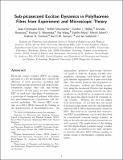Files in this item
Subpicosecond exciton dynamics in polyfluorene films from experiment and microscopic theory
Item metadata
| dc.contributor.author | Denis, J.-C. | |
| dc.contributor.author | Schumacher, S. | |
| dc.contributor.author | Hedley, Gordon James | |
| dc.contributor.author | Ruseckas, Arvydas | |
| dc.contributor.author | Morawska, Paulina Olga | |
| dc.contributor.author | Wang, Yue | |
| dc.contributor.author | Allard, S. | |
| dc.contributor.author | Scherf, U. | |
| dc.contributor.author | Turnbull, Graham A. | |
| dc.contributor.author | Samuel, Ifor David William | |
| dc.contributor.author | Galbraith, I. | |
| dc.date.accessioned | 2016-05-19T15:30:04Z | |
| dc.date.available | 2016-05-19T15:30:04Z | |
| dc.date.issued | 2015-05-07 | |
| dc.identifier | 189278342 | |
| dc.identifier | 7b93316a-e6bb-4a2c-b255-e0111caa90e3 | |
| dc.identifier | 84929012357 | |
| dc.identifier | 000354339000007 | |
| dc.identifier.citation | Denis , J-C , Schumacher , S , Hedley , G J , Ruseckas , A , Morawska , P O , Wang , Y , Allard , S , Scherf , U , Turnbull , G A , Samuel , I D W & Galbraith , I 2015 , ' Subpicosecond exciton dynamics in polyfluorene films from experiment and microscopic theory ' , Journal of Physical Chemistry C , vol. 119 , no. 18 , pp. 9734-9744 . https://doi.org/10.1021/acs.jpcc.5b00680 | en |
| dc.identifier.issn | 1932-7447 | |
| dc.identifier.other | ORCID: /0000-0002-2132-7091/work/31037454 | |
| dc.identifier.other | ORCID: /0000-0001-9114-3522/work/32543063 | |
| dc.identifier.uri | https://hdl.handle.net/10023/8836 | |
| dc.description | The authors acknowledge financial support from the UK EPSRC (Grants EP/E065066/1, EP/E062636/1, EP/J009318/1 and EP/J009019/1), from the EPSRC Scottish Centre for Doctoral training in Condensed Matter Physics and from the European Union Seventh Framework Programme under Grant Agreement 321305. | en |
| dc.description.abstract | Electronic energy transfer (EET) in organic materials is a key mechanism that controls the efficiency of many processes, including light harvesting antennas in natural and artificial photosynthesis, organic solar cells, and biological systems. In this paper we have examined EET in solid-state thin-films of polyfluorene, a prototypical conjugated polymer, with ultrafast photoluminescence experiments and theoretical modeling. We observe EET occurring on a 680 ± 300 fs time scale by looking at the depolarisation of photoluminescence. An independent, predictive microscopic theoretical model is built by defining 125 000 chromophores containing both spatial and energetic disorder appropriate for a spin-coated thin film. The model predicts time-dependent exciton dynamics, without any fitting parameters, using the incoherent Förster-type hopping model. Electronic coupling between the chromophores is calculated by an improved version of the usual line-dipole model for resonant energy transfer. Without the need for higher level interactions, we find that the model is in general agreement with the experimentally observed 680 ± 300 fs depolarisation caused by EET. This leads us to conclude that femtosecond EET in polyfluorene can be described well by conventional resonant energy transfer, as long as the relevant microscopic parameters are well captured. The implications of this finding are that dipole-dipole resonant energy transfer can in some circumstances be fully adequate to describe ultrafast EET without needing to invoke strong or intermediate coupling mechanisms. | |
| dc.format.extent | 11 | |
| dc.format.extent | 2059896 | |
| dc.language.iso | eng | |
| dc.relation.ispartof | Journal of Physical Chemistry C | en |
| dc.subject | QD Chemistry | en |
| dc.subject | QC Physics | en |
| dc.subject | NDAS | en |
| dc.subject.lcc | QD | en |
| dc.subject.lcc | QC | en |
| dc.title | Subpicosecond exciton dynamics in polyfluorene films from experiment and microscopic theory | en |
| dc.type | Journal article | en |
| dc.contributor.sponsor | European Research Council | en |
| dc.contributor.sponsor | EPSRC | en |
| dc.contributor.sponsor | EPSRC | en |
| dc.contributor.institution | University of St Andrews. School of Physics and Astronomy | en |
| dc.contributor.institution | University of St Andrews. Condensed Matter Physics | en |
| dc.identifier.doi | https://doi.org/10.1021/acs.jpcc.5b00680 | |
| dc.description.status | Peer reviewed | en |
| dc.identifier.url | http://pubs.acs.org/doi/suppl/10.1021/acs.jpcc.5b00680 | en |
| dc.identifier.grantnumber | en | |
| dc.identifier.grantnumber | EP/E062636/1 | en |
| dc.identifier.grantnumber | N/A | en |
This item appears in the following Collection(s)
Items in the St Andrews Research Repository are protected by copyright, with all rights reserved, unless otherwise indicated.

